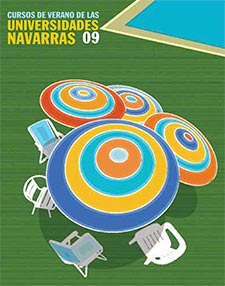BRINGING THE HERITAGE CLOSER. ESTELLA, ART AND THE ROAD
28 August 2009
Museum and city. Gustavo de Maeztu and Estella
D. Gregorio Díaz Ereño. Director of the Jorge Oteiza Museum.
In May 1935 Gustavo de Maeztu was commissioned by the Yarnoz brothers, in charge of the extension of the Palacio de la Diputación in Pamplona, to paint a series of large paintings for the Salón de Sesiones of the Diputación de Navarra. During the summer, Gustavo de Maeztu travels throughout the old kingdom collecting types and landscapes that make up a panorama of Navarre's diversity. A year later, in May 1936, and after the inauguration of his work in Pamplona, he established his home in Estella, residency program, together with his mother. What at first was a summer destination became his residency program final and a sample of love for the city that so lovingly welcomed him and that Gustavo synthesized in the expression "For London, for Estella".
Born in Vitoria in 1887, Gustavo de Maeztu is a complete artist as his friend José María Iribarren defined him, "bohemian and dandy, writer and poet, painter and aquafortista, inventor and lecturer.... An indefatigable worker and ambitious spirit, who knew how to unite art and craftsmanship, who tried to find, tormentingly, new ways and new forms of artistic expression" leaving an everlasting mark for his "renewing effort and his eagerness to try everything: fresco and oil painting, gouache and lithography, the great decoration and the tiny colored sketch".
After a life journey that took him all over Spain and part of Europe, he decided to settle in a small village where he found the friendliness and submission of the inhabitants who welcomed him with open arms in difficult life circumstances. In gratitude, shortly before his death, he told his brother Miguel: "whatever remains at my death: my paintings, my work, my workshop, for Estella". Thus began the path of a museum that, thanks to the will of people like Don Francisco Beruete and other neighbors, saw its consolidation in 1991 when the current museum was inaugurated, an example of dynamism and of how a museum does not depend on the place where it is but on the management carried out. management that has been recognized by the ICOM including it in its list of museums.
The so-called local museums are the Cinderella of culture in Spain, however, they make up the most important core of cultural activity and its management serves to value our heritage and bring it closer to visitors in a more effective way. The term local should not be disparaging as long as it values its heritage from the responsibility of a bequest that does not belong to us and that our function is to bequeath it, in the best possible conditions, to future generations. We are not its owners but its curators.
Gustavo de Maeztu was aware of the legacies that friends of his such as Ignacio Zuloaga or Santiago Rusiñol had created private museums with a pedagogical vocation and knowledge dissemination of a heritage acquired from the passion and love for history. During his life he did not have this in mind, his museum is based on gratitude to a people who welcomed him with open arms and who encouraged him, in such a difficult situation, to return to painting and, above all, once again, to writing, such an important element in his work that we can speak of a painting with a literary vocation.
The Gustavo de Maeztu Museum, since 1991, has been carrying out a work of research, conservation, dissemination and educational work that is essential to know the work and the time of Gustavo de Maeztu. Its bequest is nowadays in the most suitable hands and its vitality is an example of how the location does not condition either the activity or the prestige of the institution. An institution that depends on a municipal administration and we must not forget that most of the cultural activity in this country is generated from the town halls, from the local level.
PROGRAM
TUESDAY, AUGUST 25
The splendor of Estella in the Renaissance. Art and Artists
Ms. María Concepción García Gainza. Chair of Navarrese Heritage and Art.
Image of God, image of man: the façade of San Miguel de Estella
Mr. Javier Martínez de Aguirre Aldaz. Complutense University of Madrid
San Pedro de la Rúa: styles and interstyles in a medieval building.
D. Carlos J. Martínez Álava. I.E.S. "Pedro de Ursua" of Pamplona
WEDNESDAY, AUGUST 26TH
Following in the footsteps of the Gothic in Estella: Santo Sepulcro and Santo Domingo
Ms. Santiaga Hidalgo Sánchez. Chair of Navarrese Heritage and Art.
Estella's movable heritage
Ms. Mercedes Jover Hernando. Chair of Navarrese Heritage and Art.
A city born for the Camino. visit guided tour of the city of Estella
D. Román Felones Morrás. Full Professor of Geography and History of the I.E.S. Tierra Estella.
THURSDAY, AUGUST 27TH
Architecture and Humanism in Estella in the 16th century.
Mrs. María Josefa Tarifa Castilla. Chair of Navarrese Heritage and Art.
Traces of the Baroque in Estella
Ms. Pilar Andueza Unanua. Chair of Navarrese Art and Heritage.
The sumptuary arts in Estella: from the Age average to the 19th century.
D. Ignacio Miguéliz Valcarlos. Chair of Navarrese Heritage and Art.
FRIDAY, AUGUST 28TH
Images of a conflict. Estella and the last Carlist War
D. Ignacio Jesús Urricelqui Pacho. Chair of Navarrese Heritage and Art.
reportIdentity and image of Estella in the plastic arts of the 19th and 20th centuries.
Mr. José Javier Azanza López. Chair of Navarrese Heritage and Art.
Museum and city. Gustavo de Maeztu and Estella
D. Gregorio Díaz Ereño. Director of the Jorge Oteiza Museum.
Closing

